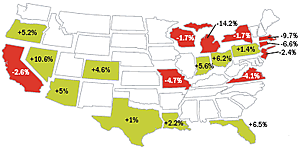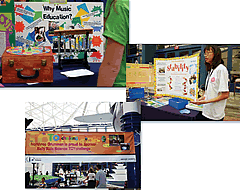Technology + Online + Industry + Partnerships
CEP: 90% of Title I Districts to See Flat or Decreased Funding
A new report says DoE statistics don’t fully reveal impactof reductions in 2006-2007 NCLB appropriations.

PLUSSES AND MINUSES The 10 biggest
Title I funding gainers and losers for 2006-2007.
THE CENTER ON EDUCATION POLICY
, a public-education advocacy group, has released a study outlining the effect of dwindling No Child Left Behind appropriations on school districts receiving Title I funding, which is meant to help children in high-poverty schools meetstate academic standards.
The CEP report, “Title I Funds—Who’s Gaining and Who’s Losing,” explains that US Department of Education statistics, which show that 38 percent of Title I districts will receive funding increases in 2006-2007, don’t account for the mandatory 4 percent of Title I funds that states must reserve for schools identified as “needing improvements.” Per NCLB, states can only draw that 4 percent from districts set to receive funding boosts. Once that money is factored in, only 10 percent of the 4,939 Title I districts will see more money this year; the other 90 percent will have their funds frozen at last year’s level or receive less.
What makes the 4 percent reservation requirement so burdensome on Title I districts is the leveling off of Title I funding. According to the CEP, the $12.7 billion appropriation for Title I, Part A grants in 2006-2007 falls slightly short ($26 million, or 0.21 percent) of the sum the program received last year, continuing a downward trend. Annual funding increases rose considerably at the advent of NCLB but have declined since 2003, and with the $26 million falloff this year, have been reversed entirely. This means that once states reserve the prescribed 4 percent for school improvements, there’s little, if any, surplus left for districts due increases. The CEP computed that in 36 states, the total allocation for districts set to receive increases was less than the 4 percent reservation; therefore all the money earmarked for “gaining districts” will be redirected to the school-improvement fund. In another four states—Delaware, Kansas, North Carolina, and South Dakota—the available funds from gaining districts barely exceeded the 4 percent requirement, leaving virtually no new funds for those districts this year.
Together, these 40 states make up 90 percent of Title I districts; hence the report’s conclusion that only 10 percent will see funding gains. Moreover, those gains will be far smaller than shown in DoE allocations. For example, in New Mexico, 85 percent of money ticketed as new Title I funds will be soaked up by the 4 percent requirement.
Meanwhile, Title I money doesn’t go as far as it used to, as the number of eligible children has risen while funding has flattened out. This year’s national per-student allocation, the report says, will drop $52 dollars off last year’s, from $1,425 to $1,373. The full report can be found here.
GOW PICKS CDW-GFOR LAPTOP ROLLOUT
UNTIL NOW, the 142 students attending The Gow School, an 80-year-old South Wales, NY, school for boys with dyslexia and other language-based learning disabilities, have used their own laptops in their studies, loading them with their choice of assistivetechnology.
That all changed last month, when Gow selected CDW-G as the school’s partner in its new one-to-one laptop computing initiative, Technology at Gow. CDW-G worked with school administrators to understand Gow students’ unique learning styles and needs in order to create a laptop solution that, according to Bob Kirby, CDW-G’s senior director for K-12,“will have the greatest impact onday-to-day student activity.”
This fall, Gow students will be provided with Lenovo laptops preloaded with Microsoft Office and assistive reading andlanguage applications.
Technology at Gow will enhance the school’s principal Reconstructive Language program, which breaks down sound, spelling rules, and grammar, as well as emphasizing vocabulary and oral reading. The school’s new Constructive Writing program will take advantage of the influx of new technology to facilitate better instruction and the use of advanced writing software.
:: Awards and Contests

TOY STORIES Sally Ride Science launches its
fifth annual Toychallenge for child engineers this fall.
RIDERS TAKE THE TOY CHALLENGE. Sally Ride Science, whose mission is to inspire girls to pursue studies in science, technology, and engineering, has announced a fall launch for Toychallenge 2007. In its fifth year, the contest features teams of fifththrough eighth-graders using their engineering skills to create the best toy in one of three categories: “Toys that Teach,” “Games for the Family,” and “Get Out and Play.”
Each team must have a coach and include between three and six members. In keeping with Sally Ride Science’s mission, boys may participate, but at least half the team members must be girls. Coaches may be anyone over the age of 18. Each toy must be original and cost less than $150 to make. The grand prize is a VIP tour of the Kennedy Space Center in Florida. For more information, click here.
TECH SWEEPSTAKES WINNERS NAMED. Bill King, a technology teacher at Central Middle School in Murfreesboro, TN, and Kitty O’Neil, a speech and language teacher at Fisher Mitchell School, an elementary school in Bath, ME, are the grand-prize winners in the “Win a Wireless Lab” sweepstakes, sponsored by CDW-G and Discovery Education to encourage expanding technology usein the classroom.
King’s school will receive 20 Lenovo tablet PCs; a PolyVision Lightning RM Easiteach calibrationfree interactive whiteboard; an InFocus LCD projector; and an HP LaserJet printer. O’Neil’s school will receive 20 HP tablet PCs; a PolyVision Lightning RM Easiteach calibration-free interactive whiteboard; an HP LCD projector; and an HP LaserJet printer. The components are installed on Bretford wireless cartswith wireless connectivity.
“Win a Wireless Lab” awarded 40 additional prizes, including projectors, Adobe software packages, and Brother and Lexmark laser printers.
:: Industry News

TECH SUPPORTER Shinawatra’s deal with
OLPC will bring computers to Thailand’s rural areas.
ONE LAPTOP PER CHILD REACHES THAILAND. Thai Prime Minister Thaksin Shinawatra has announced that this fall, One Laptop per Child will begin delivering computers to Thailand’s elementaryschool children.
The prime minister agreed to adopt the program after meeting a year ago with Nicholas Negroponte, the chairman of OLPC, which aims to bring computers to children worldwide. OLPC will deliver up to 30 computers to Thailand in October during a trial period, and more than 500 more a month later. The first batch of machines will go to children in rural areas, who have limited access to technology. After the test period is completed, the project hopes to outfit all of the country’s elementaryschool students with laptops.
The laptops, powered by an outboard electricity generator that is pumped by hand, cost about $100 each and are equipped with several modifications to conventional laptops on the commercial market. The computers being shipped to Thailand are installed with flash memory instead of hard drives, and the freeLinux operating system.
As a result of the deal with OLPC, the Thai government plans to discontinue providing books for students,“because books,” Shinawatra said, “willbe found and can be read on computers.”
FOLLETT ACQUIRES SAGEBRUSH. Follett Software Company, a K-12 library automation solutions provider, has acquired Sagebrush’s library automation business, including the Accent, InfoCentre, Athena, and Spectrum applications.
For the time being, Sagebrush will continue to operate under its own name as a subsidiary of Follett Software Company. Follett hopes the acquisition will enhance its K-12 library and school-district business, as well as its customer support.
Microsoft Settlements Mean Big Funding Gains for Florida and California Schools in Florida and California will be on the receiving end of a windfall of technology money, courtesy of the settlement of class-action lawsuits brought against Microsoft in 2003, which accused the software giant of violatingantitrust laws.
Florida schools are projected to get more than an $80 million boost from a deal that made approximately $202 million available to consumers and businesses. Microsoft agreed to commit half of any unclaimed settlement proceeds to eligible Florida schools. For a school to qualify, at least half of its students must be eligible for the federal free and reduced-price lunch program. Schools will receive vouchers from Microsoft that can be used to reimburse the purchase of any laptop, desktop, or tablet computers from any manufacturer.
Florida education officials estimate that 1,790 schools serving approximately 1.1 million students will be entitled to a share of the money. In addition to new technology items, vouchers may also be used for related professional development services such as curriculum development, training, and supplemental services for school administrators. Half the money must be used for software and the other half for hardware and other services.
Under the terms of the California case, the state’s schools will be eligible for up to $600 million in ed tech funding. Microsoft agreed to give two-thirds of any unclaimed funds from the settlement, which provided $1.1 billion to California consumers and businesses, to schools in low-income areas with high ratios (more than 40 percent) of students who qualify for free or reduced-price lunches. Schools will be able to use the money for technology maintenance, professional development, or the purchase of hardware and software.
Florida and California are not the only states to reap a financial bonanza from antitrust suits against Microsoft. Minnesota, Montana, and Vermont have benefited from similar suits.
XANDROS MAKES OFFER TO WINDOWS USERS. Citing Microsoft’s announcement that Windows 98, 98SE, and Me will no longer receive customer support, Xandros, a provider of Linux alternatives to Windows, is offering unsupported Windows users upgrades to releases of Desktop Home Edition and Home Edition Premium, which offer full support and online updates, as well as access to documents and files written on Windows or Microsoft Office programs. Xandros is also offering half-off rebates to customers who purchase an upgrade.
:: People
GEOFF FLETCHER NAMED TO SETDA BOARD. T.H.E. Journal Editorial Director Geoff Fletcher has been named to the board of directors of the State Educational Technology Directors Association. Fletcher will serve as the emeritus board member. Also named to the board was John O’Connell, educational technology director for the Iowa Department of Education.
:: Online Learning
APPLE GETS A CLUE. Apple has selected FableVision’s Get a Clue, an online vocabulary program, for inclusion in the Secondary Tools package offered with the Apple Digital Learning Series. Get a Clue is a subscription-based web application for middle and high school students that helps build vocabulary and reading comprehension.
FIRST ONLINE K-8 CHICAGO SCHOOL DUE TO OPEN. Once the Illinois State Board of Education certifies the Chicago Virtual Charter School, the city’s first K-8 online public school expects to open on Sept. 5. Approved by Chicago Public Schools in January, CVCS will be limited to a student body of 600 kids. Unlike many virtual schools, CVCS has plans to involve its students in both online and brick-and-mortar education.
Teachers will provide instruction to students during once-a-week meetings at a downtown Chicago learning center. Support and tutoring will be available to students who require further instruction— either remedial or accelerated— in the core subjects.
Although CVCS cannot accept students until the school is certified by the board of education, enrollment applications can be found online here.
Share your success! We want to know about recent promotions, changes, and hires in your education technology community. Forward the individual’s name; title; institution and location information; and any relevant educational and occupational background to [email protected]. Please write “In Brief” in thesubject line of your e-mail.